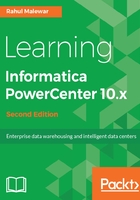
What this book covers
Chapter 1, Downloading and Extracting Informatica PowerCenter Software, describes the detailed steps for the installation process starting from the steps of downloading the software, extracting the software, installing the software and configuring the latest version of software.
Chapter 2, Understanding Admin Console, this chapter we will learn the Administrator console of Power Center tool and learn about different services. This chapter talks about creating and configuring various services and also talks about the creation of user for working on Informatica client tool.
Chapter 3, Understanding Designer Screen and its Components, talks about the basics of the Informatica Power Center Designer client tool. You will learn you use most widely used components available on the screen. The chapter also talks about working of the Source files and Source tables and similarly talks about working on targets. We have covered the steps which will help you understand how you can import/create flat files and Relational Databases tables. Also the most important aspect of Informatica Power Center tool, Mappings has been covered in the chapter. We have described in details the steps required to create a mapping. By the end of this chapter you will have clear idea about the look and feel of the Power Center Designer Screen.
Chapter 4, The Lifeline of Informatica - The Transformations is meant for the most important aspect of Informatica Power Center tool, the transformations. We will talk about various types of transformations in this chapter. Every transformation performs a specific functionality and these are the most important aspect of ETL tools. We will implement the mapping using each transformation so that you get to understand each and every transformation in details. Also we will end this chapter with the classifications of the transformation, different types of cache memories available in Informatica and different tracing levels.
Chapter 5, Using the Designer Screen - Advanced Features, talks about the advanced topics of the Designer screen. This chapter is an extension of the Chapter 3. When you work on mappings you usually will need to Debug the process to find the error in your code. Debugger helps you achieve that in very easy manner. We have added a section which will completely help you understand the process to setup the Debugger and steps to use Debugger. The next topic in this chapter talks about the reusable transformation which allows you to reuse the transformations across multiple mapping. On similar lines is Mapplet which is group of reusable transformations. Then we will talk about the Target Load plan, a functionality which allows you to load data in multiple targets in a same mapping maintaining their constraints. It's a very high level concept which you may not need regularly. Also we have touch based on the Compare Objects functionality of the Designer Screen, this allows you to compare objects across the repository.
Chapter 6, Implementing SCD - Using Designer Screen Wizards, covers a single but very important aspect of Data Warehousing, i.e. SCD. We have made a separate chapter for this because this is most important aspect and frequently used concept in Data Warehousing. In this chapter we have outlined the steps required to create a SCD mapping using the wizards in Power Center. We will see the implementation of SCD1, SCD2 and SCD3 using wizards. You should be clear with the Data Warehousing concepts to understand this implementation.
Chapter 7, Using the Workflow Manager Screen, describes the basics of the Workflow Manager screen. This is the second and last phase of our development work. We will get to learn the different option present on the Workflow Manager screen. We will learn to create session task and workflows. We will also see various connections like Relations, FTP etc. which can be created in Workflow Manager screen. We will also learn to execute the workflow. Last topic of the chapter describes about the connections which can be created for database purpose.
Chapter 8, Learning various tasks in Workflow Manager Screen, will teach you the advanced concepts of the Workflow Manager screen. This chapter describes various tasks present in the workflow manager screen. Tasks are the basic building blocks of the workflow as we have transformations in Designer screen. We will also see to make the reusable tasks and Mapplets.
Chapter 9, Advanced features of Workflow Manager Screen, We will see some very important concepts called as Scheduling, Parameter Files, File List and Incremental Aggregation.
Chapter 10, Working with Workflow Monitor Screen, Monitoring the code describes the Workflow Manager screen of Power Center. This screen allows the monitoring of the process we execute in the Workflow Manager. We will see different log files, status and statistics in the Monitor screen.
Chapter 11, The Deployment Phase - Using the Repository Manager is going to teach you about the fourth client screen Repository Manager. Repository Manager is basically used for Migration (Deployment) purpose. We will see various options to migrate the code from one environment to other. Also we will see how to create the folder in client screen.
Chapter 12, Optimization - The Performance Tuning, has the contents for the optimizations of various components of Informatica Power Center tool like Source, targets, Mappings, Sessions, Systems. Performance tuning at high level involves 2 stages, finding the issues called as Bottleneck and resolving them.